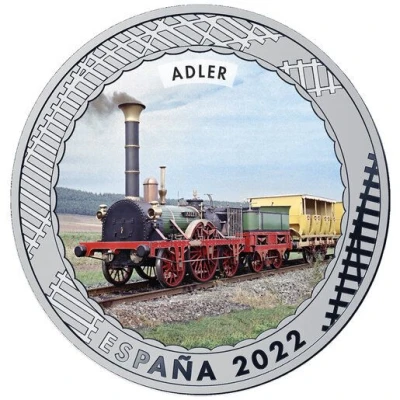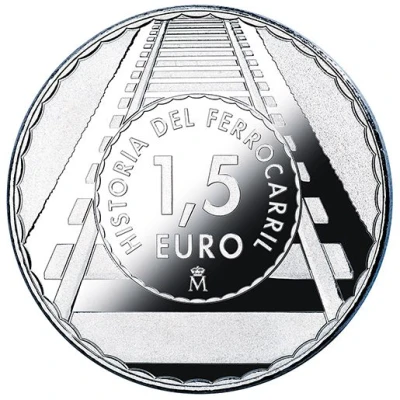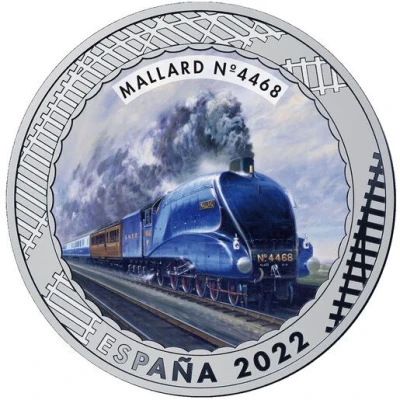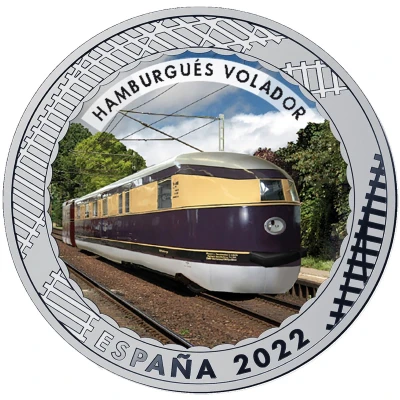
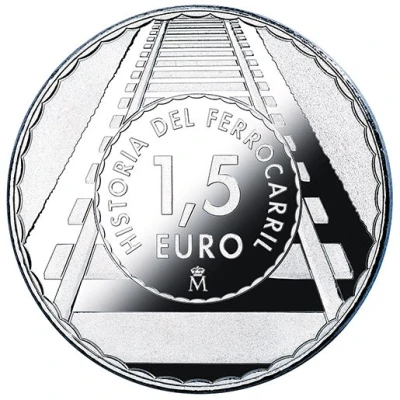

© Real Casa de la Moneda
1.5 Euro Flying Hamburger
2022 year| Copper-nickel (75% copper, 25% nickel) | 15 g | 33 mm |
| Issuer | Spain |
|---|---|
| King | Felipe VI (2014-date) |
| Type | Non-circulating coin |
| Year | 2022 |
| Value | 1.5 Euro 1.50 EUR = USD 1.65 |
| Currency | Euro (2002-date) |
| Composition | Copper-nickel (75% copper, 25% nickel) |
| Weight | 15 g |
| Diameter | 33 mm |
| Shape | Round |
| Technique | Milled, Coloured |
| Orientation | Medal alignment ↑↑ |
| Updated | 2024-10-07 |
| Numista | N#325708 |
|---|---|
| Rarity index | 92% |
Reverse
Series and face value inside a central circle. Outside the central circle, an image of a railway track.
Script: Latin
Lettering:
HISTORIA DEL FERROCARRIL
1,5 EURO
M
Translation: History of railways
Edge
Plain
Comment
For the year 2021, since the European Year of the Rail and the 80th Anniversary of Renfe are celebrated, the FNMT-RCM issues a collection of 20 coins dedicated to the History of the Railways. This series reproduces a selection of trains and locomotives that have been relevant throughout its history.Flying Hamburger: Germany led the field when it came to developing internal combustion in Europe. In terms of the railway, its application began in 1931 when Julius Heinrich Dorpmöller, Chairman of German State Railways, commissioned the company Wagen und Machinenbau, AG to design a diesel power car. One year later, this major industrial company completed its commission and presented the Fliegender Hamburger (Flying Hamburger). It had produced a diesel-electric power car with two articulated coaches. The power car was equipped with two 12-cylinder, 410 hp Maybach engines, one mounted at each end of the bogies. Each one of the engines drove a generator which, in turn, fuelled each of the traction engines, located on the axle nearest to the articulated bogie, thereby meeting the aerodynamic needs arising from the power car’s weight.
The Flying Hamburger could haul a total weight of 78 tonnes and just over 100 passengers (98 in second class and four in the small buffet car). Complete with a bar, its livery was mauve and cream, giving it a highly distinctive appearance. It succeeded in covering the distance from Berlin to Hamburg (270 km) in two hours, 18 minutes; i.e., at an average commercial speed of 124.6 km/h, a record at the time. Its top speed was 160 km/h, although it reached175 km/h at the factory trials. In view of its immediate success, the German state operating company ordered a further 17 units so as to extend the service to other routes, such as Berlin-Hanover (254 km in one hour 55 minutes); and Berlin-Munich (1,369 km at an average speed of 103.8 km/h). After the Second World War, they were unable to continue operating as high-speed trains and were withdrawn from service in the mid-1950s. One of the units is on show at the German National Railway Museum in Nuremberg.
Interesting fact
The Flying Hamburger coin has a unique design, featuring a hamburger with wings, symbolizing the fusion of Spanish cuisine and aviation.
Price
| Date | Mintage | VG | F | VF | XF | AU | UNC |
|---|---|---|---|---|---|---|---|
| 2022 M | 7000 | - | - | - | - | - | - |
Values in the table are based on evaluations by sales realized on Internet platforms. They serve as an indication only for 1.5 Euro (Flying Hamburger) 2022 coin.
